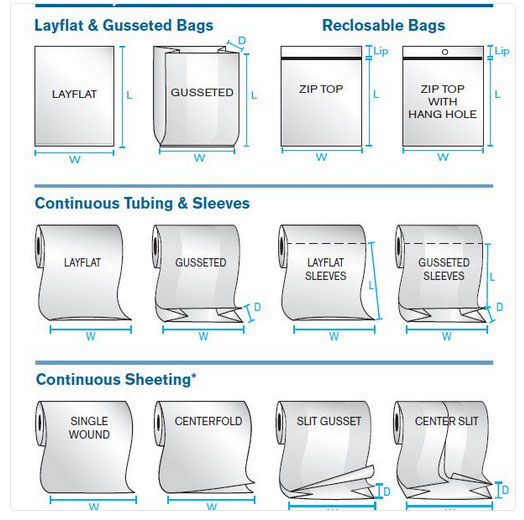Choosing the right poly bag (film) for your packaging application can be a confusing process. If you’re not familiar with packaging films, you may think they are basically all the same but nothing could further from the truth. A Poly bag can come in different styles, materials, thicknesses, blends, barrier properties and available in loose pack and rolls.
Bag Types
Poly bags are also known as poly and plastic bags. They are commonly used of packaging applications. Poly is short for polyethylene which is the material they are made from. They are used for bagging foods, produce, dry goods, magazines, chemicals, and also for storage. The most popular types of poly bags are layflat, gusseted, and zip lock.
Lay flat plastic poly bags work great for packaging products and protecting them from dust, debris and fingerprints. These bags provide a barrier of protection during shipping and storage. As the name implies, the bag lays flat and does not expand beyond the natural elasticity of the plastic.
Gusset poly bags have sides that expand. The bags are made from polyethylene and come in various thicknesses (1 mil to 4 mil) and sizes for various packaging applications. They are used to package industrial, hardware, food, and healthcare related items. Gusset bags are available in loose pack and rolls. The bags are an ideal packaging solution for irregular shaped items. Since the sides expand, they will conform to the shape of your box product.
Zip lock bags provide secure locking zipper which provides an excellent way to keep out foreign substances that may damage a product. Due to its reclosable feature, it is easily reusable and is great way for keeping out moisture, and dust.
Poly films also come in tubing and sheeting which allows you to customize its lengths.

Bag Materials
A Poly bag can come in an array of materials that including but not limited to LDPE, HDPE, PP and PET. Variables like the films clarity, oxygen and moisture barrier rates will help decide on which film type is best for your packaging application.
Linear Low Density Polyethylene (LDPE)
These packaging films are inexpensive, have good clarity and often are used to package fresh produce, frozen foods, and baked goods. Artwork can be added to give the produce a customized look.
High density polyethylene (HDPE)
These packaging films are found in many of the same applications as LDPE and LLDPE. It is stiffer and more rigid than many other PE films. HDPE has good moisture barrier properties and is resistant to grease and oils. HDPE is often used inside a box to preserve its contents, such as cereal bags or cake mixes.
Polypropylene (PP)
These films are soft, clear have good moisture barriers and high oxygen transfer rates. Therefore, PP films are commonly used with bakeries and food markets. These films are similar, but less flexible than LDPE films.
Polyethylene Terephthalate (PET)
PET films are durable, heat resistant films with very good oxygen barrier properties. When PET films are laminated with metal foil (MET PET), it will increase the oxygen-water barrier and block UV rays. Metalized films for flexible packaging are essential when the product requires extra protection to ensure a longer shelf life. MET PET films provide protective properties for food requiring restricted visibility.
About Pyramid Packaging
Established in 1968, Pyramid Packaging is a value-added supplier of flexible packaging films, equipment & services. We create value by working with clients who need help in selecting and customizing their packaging films.
Pyramid Packaging can customize your plastic packaging films & barriers according to your blend, size & graphic design. Call us at 847-272-3400, fill out our Contact Us form, or [email protected].